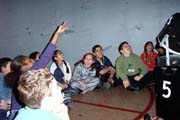Bright lights and air pollution can make it difficult for an aspiring astronomer in Hudson County to study space.
And try teaching third and fourth graders about the great beyond without having something substantive to work with. There are class trips to a local planetarium, but those can take time and be costly.
That’s why the North Bergen Board of Education decided to bring the planetarium to the students. Last week, traveling astronomer John Miller of Pearl Observatory from Green Brook, N.J. brought a portable planetarium to Horace Mann School so the students could have the chance to learn about the stars, constellations, the Solar System, and the galaxy in their own gymnasium.
Miller said this traveling universe in an inflatable bubble was invented by scientists at the Massachusetts Institute of Technology six years ago, and he has been transporting it to schools all over North America.
“By being 100 percent mobile, there’s no cost in transporting the kids to a planetarium,” said Miller, who also teaches astronomy at Raritan Valley Community College in North Branch. “It’s a great opportunity to let the students be aware of what’s out there, what they can find. They know that the constellations are out there, but they just have to know how to find them. This way, they can see the constellations in the location they are in the sky. It helps them get more interested in astronomy, which is the world’s oldest science.”
According to Assistant Superintendent of Schools Nicholas Sacco, who is also the township’s mayor, the roving planetarium was made possible from a $2,800 Eisenhower grant, secured from a federal program organized by the state Department of Education.
“Our science director, Bob Dandorph, saw it in Edgewater a few months ago and thought it was wonderful for our kids,” Sacco said. “Instead of bringing the kids on a field trip, we can have it right here in the gym. They’re in a familiar setting and they pay attention more. It’s a 40-minute program and it’s a great learning experience for the kids.”
Miller will bring the program to all of the district’s third and fourth graders over the next few months. Its next visit will be to the Robert Fulton School in March and it is slated to go to more schools in April.
Horace Mann Principal Jorge Prado thought the program was a tremendous asset to the school’s core science curriculum. “It is pretty amazing,” Prado said. “The students go through a tube and then are inside the bubble dome. The bubble is held up by air and the students sit in a circle and watch the presentation. It’s always been a thing for kids, to make science as much fun as possible. By bringing the planetarium to the students, it makes learning easier and makes it accessible to a larger numbers of students. Once they’re done with the presentation, they can go back to the classroom and continue their day.”
The students seemed to like it as well. “It was very exciting for me,” said 10-year-old Daniel Barcia, a fourth grader. “I got to learn things about space that I didn’t know. I like stars and I like looking at them and the constellations. It was fun, because I saw things that I don’t normally get to see in the city. I saw things that I could have never experienced.”
Fellow fourth grader, Sammy Davalos, 10, agreed.
“I was a little nervous climbing into the bubble, but then when it started, I was so excited,” Davalos said. “It was a lot of fun and I learned a lot about the constellations and how they were formed. I think I can understand them all now much better and what they mean. I saw things that I never imagined I could see.”
New world
Miller said that most students really enjoy the presentation, because the material is so new to them. “They climb in and wonder if they’re going to float inside there,” Miller said. “They all know it has something to do with space and they all love that idea. As an astronomer, I’m all for spreading the word about my field. I like being out there and being with the eager kids. I have fun doing it, but they are all so eager to learn.”
Miller said that the planetarium takes only a few minutes to set up and break down after the presentation. “Everything gets carted out in three or four boxes,” Miller said. “Most of the equipment I carry is in a gym bag. It is very mobile. You would be surprised how much we can get into it once it’s compressed.”
Miller added, “The children have so much fun that they don’t even know they’re learning. Plus, the children can then go home and show their parents what they learned.”
Prado said that more educational companies are devising ways to bring learning to the students, instead of students going to it.
“They want to be able to make their product accessible to as many students as possible,” Prado said. “That’s why we see more and more programs like this one.”
